
A meteorite is a solid piece of debris from an object, such as a comet, asteroid, or meteoroid, that originates in outer space and survives its passage through the atmosphere to reach the surface of a planet or moon. When the original object enters the atmosphere, various factors such as friction, pressure, and chemical interactions with the atmospheric gases cause it to heat up and radiate energy. It then becomes a meteor and forms a fireball, also known as a shooting star; astronomers call the brightest examples "bolides". Once it settles on the larger body's surface, the meteor becomes a meteorite. Meteorites vary greatly in size. For geologists, a bolide is a meteorite large enough to create an impact crater.
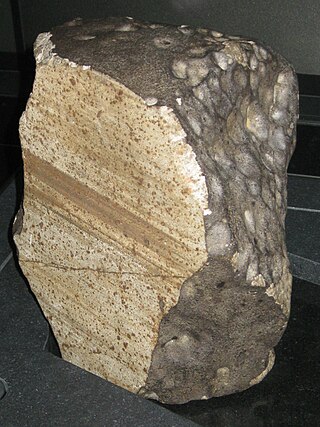
The Wold Cottage meteorite fell near Wold Cottage farm in 1795, a few miles away from the village of Wold Newton in Yorkshire, England.

Heat Shield Rock is a basketball-sized iron-nickel meteorite found on the Meridiani Planum plain of Mars by the Mars rover Opportunity in January 2005.

The Cape York meteorite, also known as the Innaanganeq meteorite, is one of the largest known iron meteorites, classified as a medium octahedrite in chemical group IIIAB. In addition to many small fragments, at least eight large fragments with a total mass of 58 tonnes have been recovered, the largest weighing 31 tonnes. The meteorite is named after the location where the largest fragment was found: 23 miles (37 km) east of Cape York, in Savissivik, Meteorite Island, Greenland.
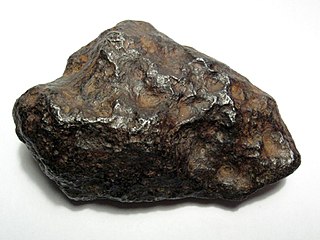
Ataxites are a structural class of iron meteorites with a high nickel content and show no Widmanstätten patterns upon etching.

The pallasites are a class of stony–iron meteorite. They are relatively rare, and can be distinguished by the presence of large olivine crystal inclusions in the ferro-nickel matrix.
Kaidun is a meteorite that fell on 3 December 1980 on a Soviet military base near what is now Al-Khuraybah in Yemen. A fireball was observed travelling from the northwest to the southeast, and a single stone weighing about 2 kilograms (4.4 lb) was recovered from a small impact pit. It has been suggested that Kaidun originated from the Martian moon of Phobos, but this is disputed.

Mesosiderites are a class of stony–iron meteorites consisting of about equal parts of metallic nickel-iron and silicate. They are breccias with an irregular texture; silicates and metal occur often in lumps or pebbles as well as in fine-grained intergrowths. The silicate part contains olivine, pyroxenes, and Ca-rich feldspar and is similar in composition to eucrites and diogenites.

A meteorite fall, also called an observed fall, is a meteorite collected after its fall from outer space was observed by people or automated devices. Any other meteorite is called a "find". There are more than 1,300 documented falls listed in widely used databases, most of which have specimens in modern collections. As of February 2023, the Meteoritical Bulletin Database had 1372 confirmed falls.
Meteorite fall statistics are frequently used by planetary scientists to approximate the true flux of meteorites on Earth. Meteorite falls are those meteorites that are collected soon after being witnessed to fall, whereas meteorite finds are discovered at a later time. Although there are 30 times as much finds than falls, their raw distribution of types does not accurately reflect what falls to Earth. The reasons for this include the following:

L'Aigle is a L6 meteorite that fell on 26 April 1803 in Lower Normandy, France.
Omolon is a meteorite fallen in 1981 in the Omolon River basin, Magadan (Russia). It is a pallasite.
Mineo was one of the only four witnessed fall pallasite meteorites in the world, and the only one from Italy.
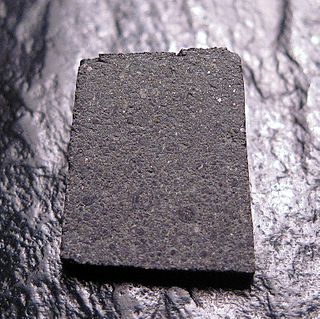
Moss is a carbonaceous chondrite meteorite that fell over the communities of Rygge and Moss in Østfold county, southeast southern Norway in the morning of midsummer day, July 14, 2006.
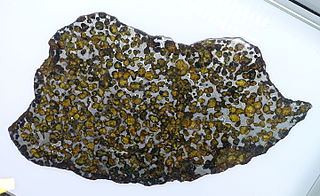
The Springwater meteorite is a stony-iron pallasite, found near Springwater, Saskatchewan in 1931. At that time the find consisted of three large masses (38.6 kilograms, 18.6 kilograms and 10.6 kilograms. Other fragments have been found recently, including a 53 kilograms individual in 2009 that is now in the Royal Ontario Museum.

Millbillillie meteorite is a meteorite named after the cattle station in Western Australia on which it fell in October 1960. It is classified as a eucrite achondrite, a kind of stony meteorite.

IIAB meteorites are a group of iron meteorites. Their structural classification ranges from hexahedrites to octahedrites. IIABs have the lowest concentration of nickel of all iron meteorite groups. Most iron meteorites are derived from the metallic planetary cores of their respective parent bodies, but in the case of the IIABs the metallic magma separated to form not only this meteorite group but also the IIG group.

Yamato 000593 is the second largest meteorite from Mars found on Earth. Studies suggest the Martian meteorite was formed about 1.3 billion years ago from a lava flow on Mars. An impact occurred on Mars about 11 million years ago and ejected the meteorite from the Martian surface into space. The meteorite landed on Earth in Antarctica about 50,000 years ago. The mass of the meteorite is 13.7 kg (30 lb) and has been found to contain evidence of past water alteration.
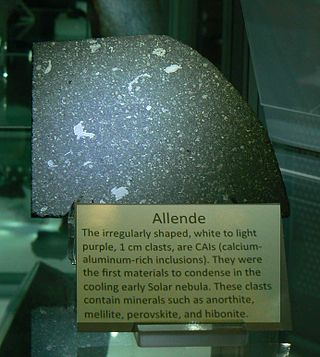
Hemolithin is a proposed protein containing iron and lithium, of extraterrestrial origin, according to an unpublished preprint. The result has not been published in any peer-reviewed scientific journal. The protein was purportedly found inside two CV3 meteorites, Allende and Acfer-086, by a team of scientists led by Harvard University biochemist Julie McGeoch. The report of the discovery was met with some skepticism and suggestions that the researchers had extrapolated too far from incomplete data.















